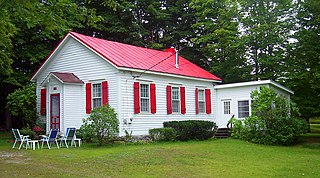
The Pearl Street Schoolhouse, also known as District 11 Schoolhouse, is located south of the junction of Awosting and Decker roads in the Town of Shawangunk, New York, United States. It was built around 1850.

Bruynswick School No. 8 is a former school located on Bruynswick Road in the small hamlet of the same name in the northwestern portion of Shawangunk, New York, United States. It is one of the few remainders of a time when Bruynswick was more populous.
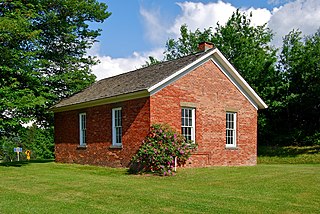
The District #6 Schoolhouse, also known locally as the Little Red Schoolhouse or the Lincoln School, located in Brunswick, New York, United States, is a one-room schoolhouse built c. 1830 or 1837 that was home to grades one through eight until the consolidation of Brunswick (Brittonkill) Central School District in 1952. It was added to the National Register of Historic Places (NRHP) on July 3, 2008 and a dedication ceremony for the accomplishment was held on June 12, 2009.

District School Number Five, also known as "The Little Red Schoolhouse," is a historic one room school building located at Campbell in Steuben County, New York. It was built during the spring and summer of 1839 with a hand hewn timber frame of mortise and tenon construction. The schoolhouse is part of the Watson Homestead Conference and Retreat Center, deeded to the Genesee Conference of the Methodist Church by IBM founder Thomas J. Watson, Sr. Watson attended the school as a child. Also on the property is a small frame structure that served as privy and woodshed.

Wallington Cobblestone Schoolhouse District No. 8 is a historic one room school located at Sodus in Wayne County, New York. The Federal style, cobblestone building is a one-story, three bay, center hall gable roofed structure with a louvered, gable roofed bell tower.

Sterling District No. 5 Schoolhouse is a historic school building located at Sterling in Cayuga County, New York. It was built about 1853 and is a two-story hewn timber frame building with a front-facing gable roof, built above a mortared rubble stone foundation. It is rectangular in shape and measures 28 feet by 38 feet. It was used as a school into the 1950s. It has since been used by the Sterling Historical Society for museum display space and as the Town Hall.
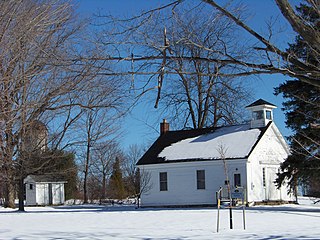
Pompey Centre District No. 10 Schoolhouse is a historic one-room school building located at Pompey Center in Onondaga County, New York. It is a one-story frame building on a stone foundation, 24 feet wide and 32 feet deep. The roof features a small belfry. It was built in 1857 and ceased being used as a school in 1943.

Mycenae Schoolhouse is a historic one-room school building located in the hamlet of Mycenae in the town of Manlius in Onondaga County, New York. It is a one-story building built of locally quarried limestone with a low-pitched gabled roof in the Greek Revival style. The roof features a small belfry. It was built in 1850 and ceased being used as a school in 1936.

District School No. 3, also known as Putnam Schoolhouse, is a historic one-room school building located at Lyme in Jefferson County, New York. The schoolhouse consists of a 1 1⁄2-story, two-by-three-bay wood-frame main block constructed about 1875, and a 1-story, two-by-one-bay rear addition constructed about 1900. Also on the property is a double privy dating to about 1900.
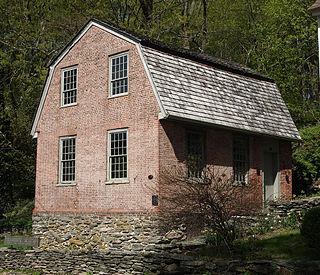
The East District School is a historic school building at 365 Washington Street in Norwich, Connecticut. Built in 1798, it is significant as a rare and well-preserved 18th-century schoolhouse, and as the location of an evening school for adults established by Consider Sterry, author of an early guide to practical navigation. The school was listed on the National Register of Historic Places in 1970, and is a contributing property to the Norwichtown Historic District.

Wethersfield Stone Schoolhouse is a historic one room school building located at Trenton in Oneida County, New York. It was built about 1825 and is a vernacular one story, rectangular, gable roofed, stone masonry structure, 26 by 30 feet. It functioned as a public school until 1934.

New Stone Hall is a historic school building located at Franklin in Delaware County, New York, United States. It was built in 1855–1856 and is a three-story rectangular building, eight bays wide and three bays deep. It features a slate-covered hipped roof and octagonal cupola. It was built as the main academic building of the Delaware Literary Institute, then later used by the local school system. It was abandoned in 1932. It is located within the Franklin Village Historic District.

Little Red Schoolhouse, also known as Columbia School District No. 5 Schoolhouse, is located in Florham Park, Morris County, New Jersey, United States. The schoolhouse was built in 1866 and was added to the National Register of Historic Places in 1973 and then re-instated in June 6, 1986. It is open to the public the first Sunday of most months with hours of 2:00-4:00pm. Open each July 4, from 1:00-3:00pm. Entrance donations are accepted and appreciated. As a museum it includes artifacts such as broom making equipment, old maps and old school desks, and more from the 1800s and 1900s. Come ring the school bell!
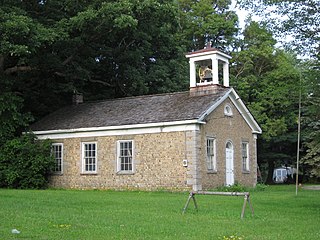
Schoolhouse No. 6 is a historic one room school building located at Guilderland in Albany County, New York. It was built in 1860 and is a one-story cobblestone building built of coursed cobblestones with smooth ashlar quoins. It features a curvilinear hipped roof topped by an open bell tower. Also on the property is a contributing privy.

Verdoy Schoolhouse, also known as District No. 7 Schoolhouse, is a historic one-room school building located at Newtonville in Albany County, New York. It was built in 1910 and is an asymmetrical frame building. It features a slate covered hipped roof crowned by a small belfry and a massive chimney at the center of the roof. Until 1996 when moved to the grounds of the Casparus F. Pruyn House, the school was located on Troy-Schenectady Rd. and was previously listed in 1985 as the Verdoy School.

District School No. 1, also known as Cedar Hill Schoolhouse, is a historic school building located in the Town of Bethlehem in Albany County, New York south of the capital. It was built in 1859 and expanded in 1907. It is a one-story, rectangular brick building, seven bays by three bays in the Italianate style with later Neoclassical details. It features an elaborate domed cupola. School use ceased in 1962. Since 1965 it has housed the Bethlehem Historical Society and museum.

Jerusalem District No. 5 Schoolhouse is a historic one-room school building located at 3510 Old Jerusalem Rd, Wantagh, New York in Nassau County, New York. It is owned by Levittown Union Free School District #5. It was built in 1876 and enlarged to three rooms about 1920. It is a "T" shaped building with the original section located at the rear. It is a long frame building on a poured concrete foundation and hipped roof with shallow overhanging eaves. The main entrance features a portico. It is now leased out to a private day care facility.

Mayer Red Brick Schoolhouse is a building in Mayer, Arizona. It was listed on the U.S. National Register of Historic Places in 2004. It is considered the longest used schoolhouse in Arizona, having been in operation for over eighty years. Due to its physical mass and prominent hillside location, it is "the most visible and identifiable building" in the small unincorporated town and the town's largest building.
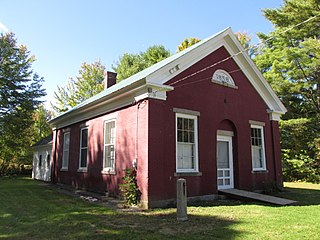
The District No. 2 Schoolhouse, also known as the Little Red Schoolhouse, is a historic one-room schoolhouse at 2851 Wakefield Road in Wakefield, New Hampshire. Built in 1858–59, it was at the time one of the finest district schoolhouses in rural New Hampshire. It was used as a school until 1941, and now houses the museum of the local historical society. The building was listed on the National Register of Historic Places in 1980.

The Pleasant Hill School, also known as the Little Red School House, is a historic building located north of Lineville in rural Wayne County, Iowa, United States. It was built in 1881 on land that had been purchased for educational purposes in 1873, and it housed a one-room school until 1958. The Grand River Independent School District donated the school building to the Wayne County Historical Society. They maintain it as it was when it served as a schoolhouse. The interior furnishings are authentic, if not original to the building. The school yard is maintained as a roadside park along U.S. 65. The building follows a rectangular plan that is three bays long and two bays wide. It is capped with a gable roof. A small entryway is located on the south side of the structure. The school building was listed on the National Register of Historic Places in 1975.
























